Michael McDowell’s front-yard prairie garden
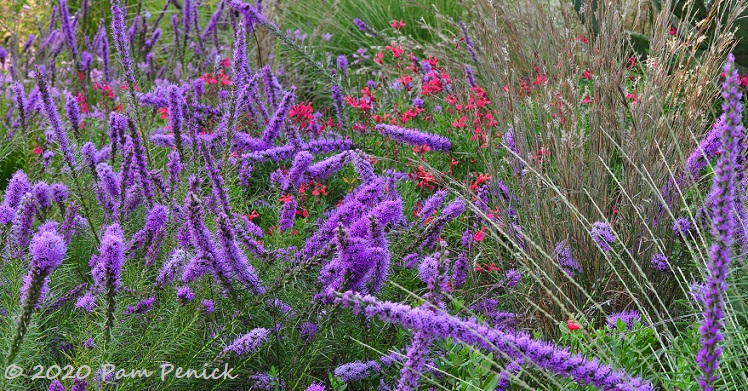
How can it have been 9 years since I first visited Michael McDowell’s front-yard prairie garden? Michael’s garden lives large in my memory, alight with morning sunlight and festive fall color (click for my 2011 tour), and it inspires daily via his blog Plano Prairie Garden and his Instagram.
For my birthday a couple weekends ago, I treated myself to a covid-careful Dallas/Fort Worth garden-visiting trip. Michael’s garden in Plano, a suburb of Dallas, was one I was keen to revisit. Would it hold up to my memories?
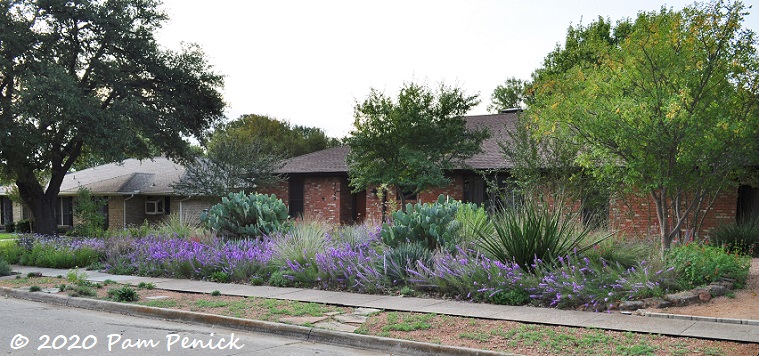
Of course it did! I mean, just look at it. Amid a sea of mown lawns, Michael’s native-plant front garden beckons like an oasis in the desert. It must also look that way to pollinators, birds, and other small creatures looking for a refueling stopover or place to take shelter. The seedlings coming up in the hellstrip, by the way, are native bluebonnets, which will put on a show next April.
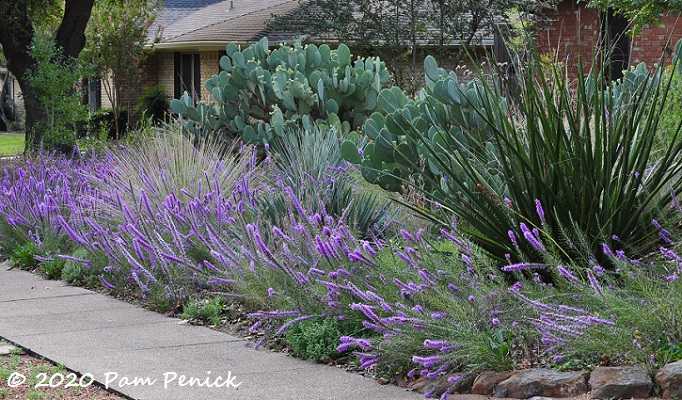
I’ve already written in detail about Michael’s garden in my earlier post, so this one will be mostly eye candy. I caught the fall-blooming gayfeather (Liatris) in full flower, to my delight. Michael later told me it began to fade by the following weekend, as the heat returned.
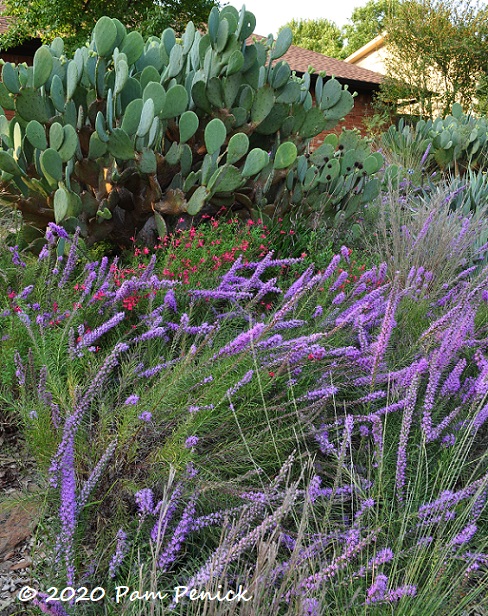
Liatris is glorious in bloom, especially juxtaposed with a hulking spineless prickly pear and complemented by the red flowers of autumn sage (Salvia greggii).
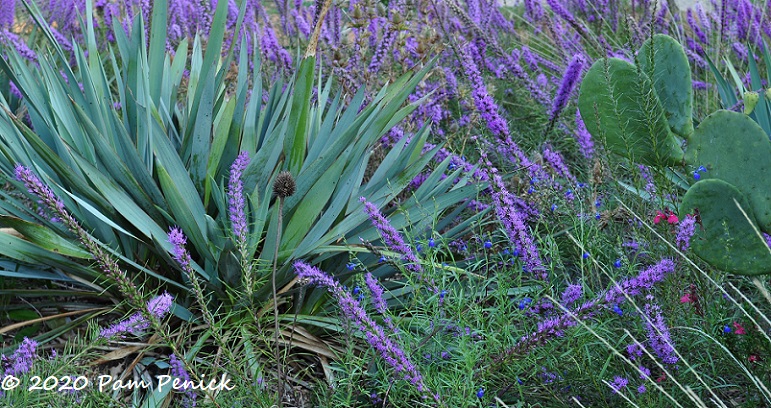
Evergreen xeric plants like prickly pear and paleleaf yucca (Yucca pallida) give Michael’s garden structure and interest when the garden isn’t in full flower. Update: Michael has ID’d the blue flower as Salvia reptans, a new favorite plant.
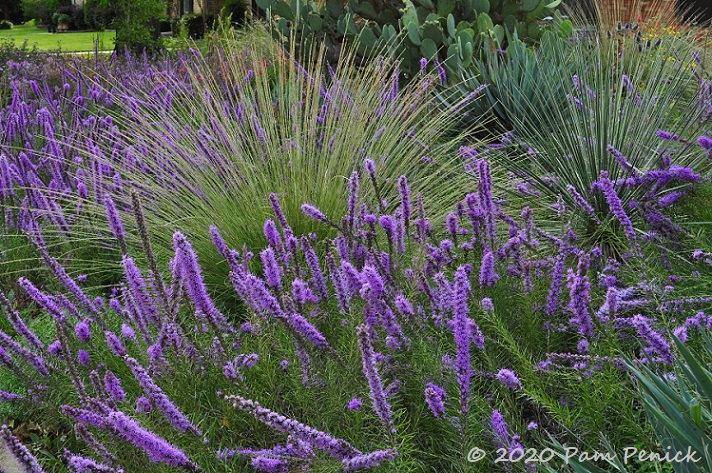
Fine-textured pine muhly (Muhlenbergia dubia) also blooms at this time of year and looks stunning with the liatris.
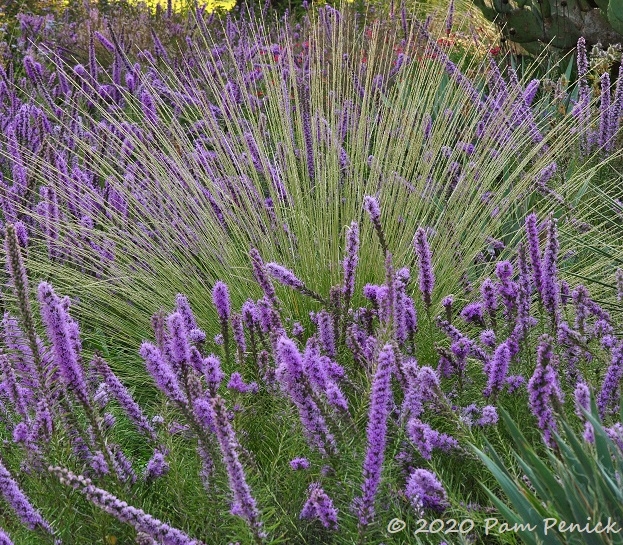
A closer look
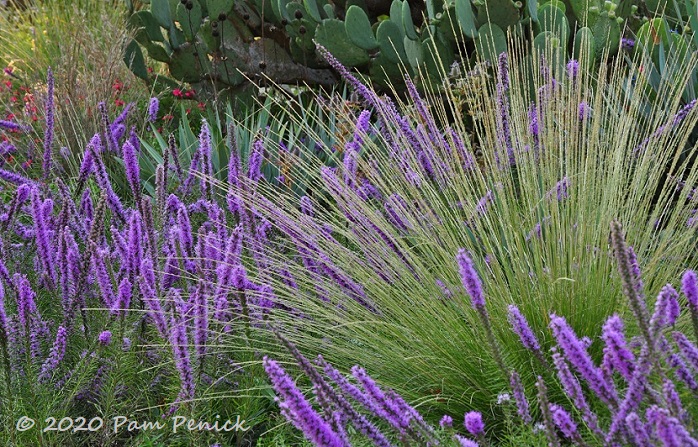
And here it is from another angle, with yucca and prickly pear added to the mix.
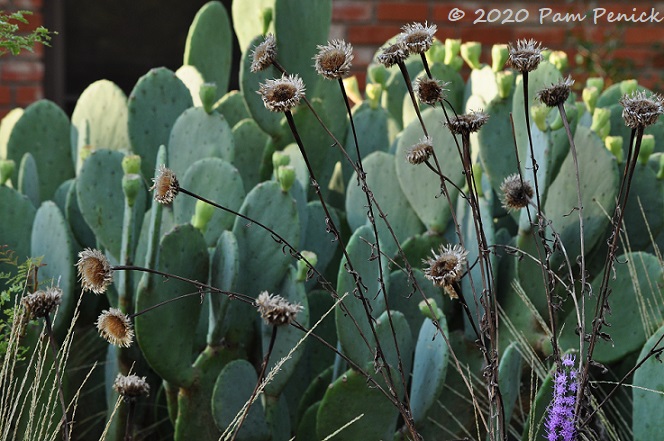
American basketflower (Centaurea americana), an excellent pollinator plant, has gone to seed.
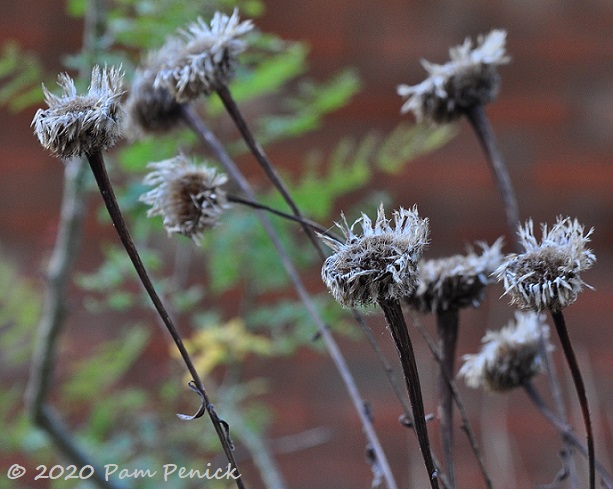
The tan-and-chocolate seedheads are pretty and feed songbirds.
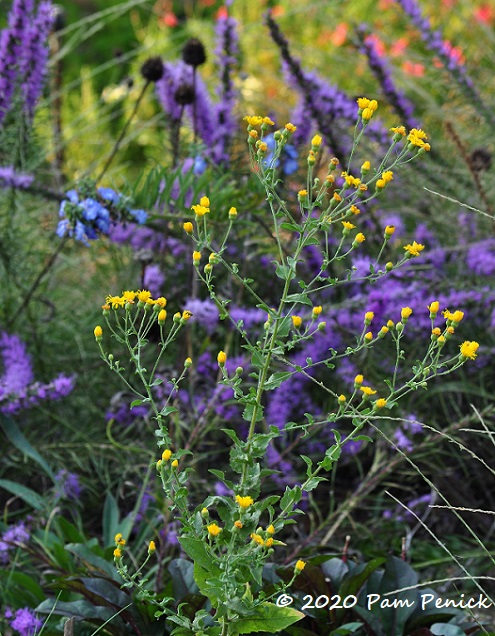
Michael tentatively identified this yellow-flowered plant as camphorweed (Heterotheca subaxillaris). It appeared in his garden as a volunteer seedling.
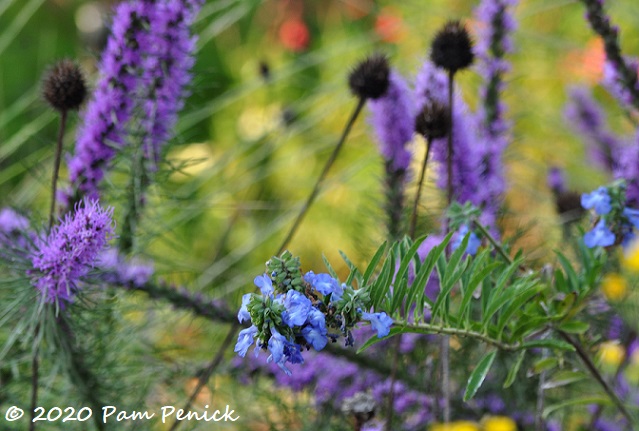
Pitcher Sage (Salvia azurea) adds sky-blue amid the purple liatris.
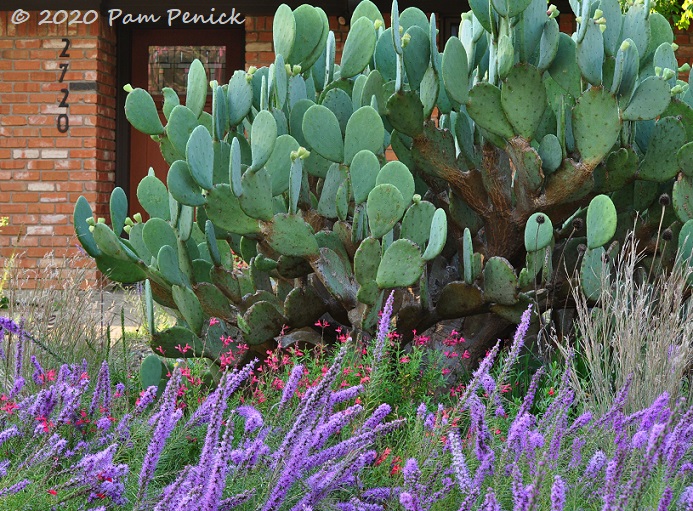
Spineless prickly pear, red autumn sage, and liatris
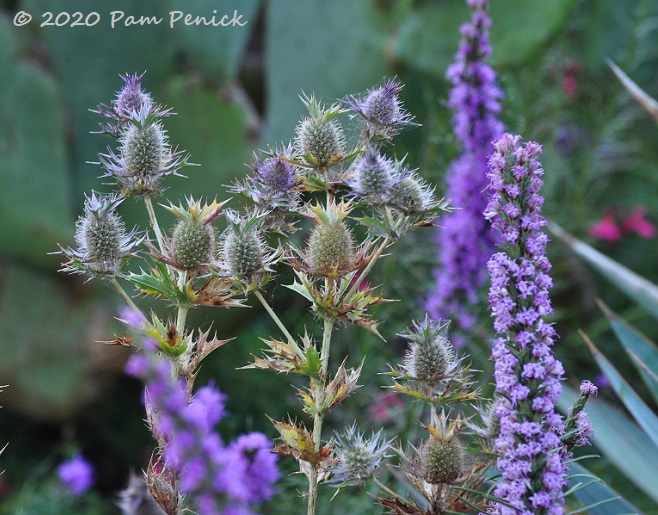
Eryngium fades from purple to tan as it goes to seed, but the spiny cones still add interesting texture to the garden.
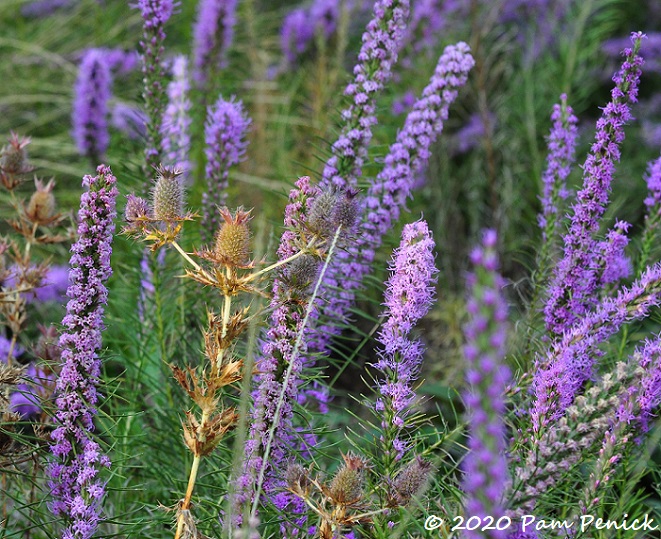
Another eryngium candelabra
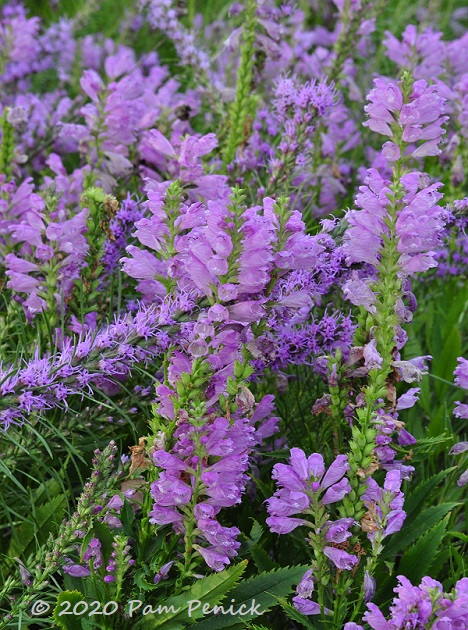
Obedient plant (Physostegia virginiana), a shade lighter than the liatris, makes for a pretty purple combo.
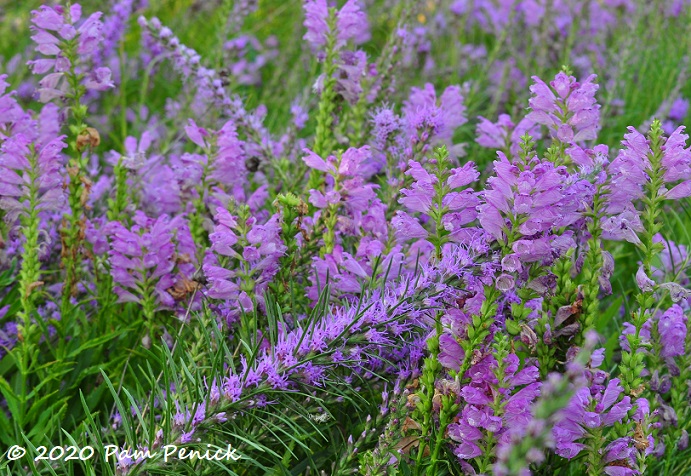
Michael showed me how obedient plant got its name: if you push an individual flower with your finger, it moves as if on a hinge and stays in its new position.
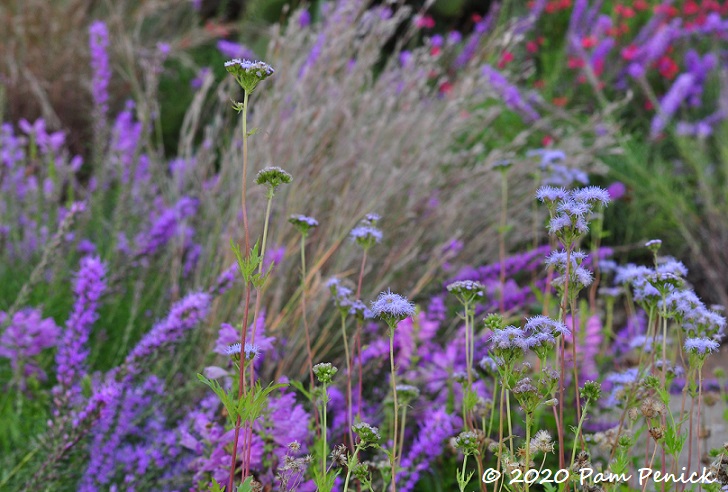
Gregg’s mistflower (Conoclinium greggii) stands upright on long stems.
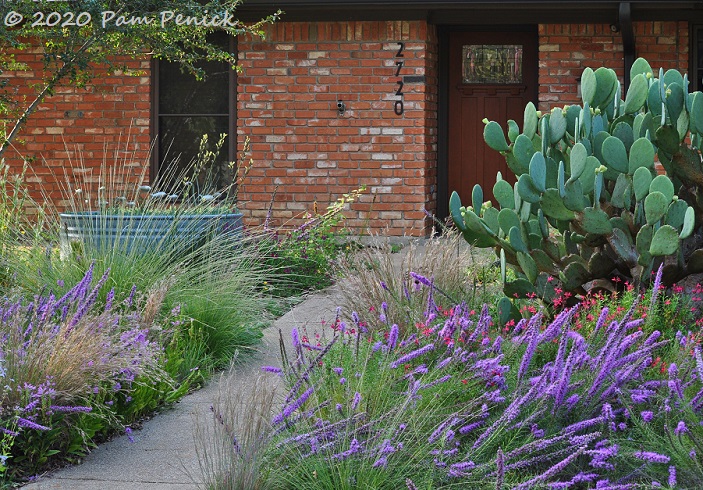
It’s like taking a meadow stroll to reach the front door.
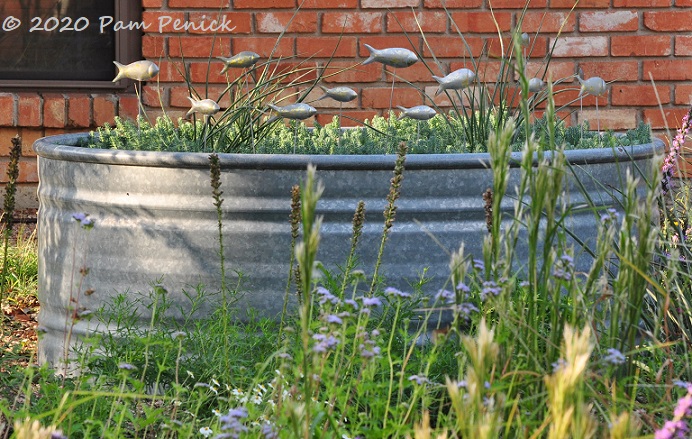
Near the front door, a stock tank that held horsetail the last time I visited has been replanted with ‘Blue Spruce’ sedum and small hesperaloes (‘Brakelights’ maybe?) and adorned with silver metal fish.
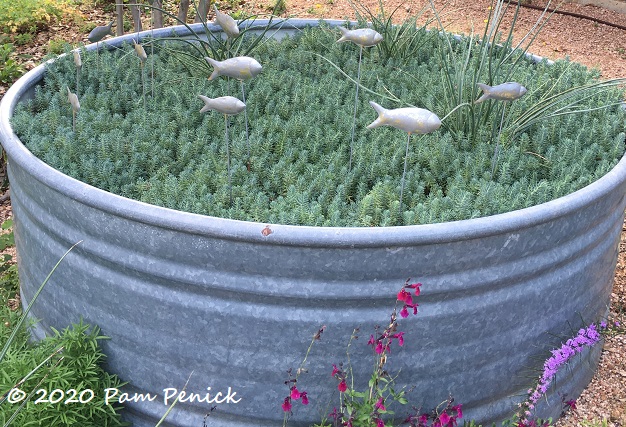
The blue-green sedum bears a strong resemblance to seaweed on the ocean floor, which the fish appear to be swimming over. So clever! Michael is good at creating surprising and water-evoking vignettes like this.
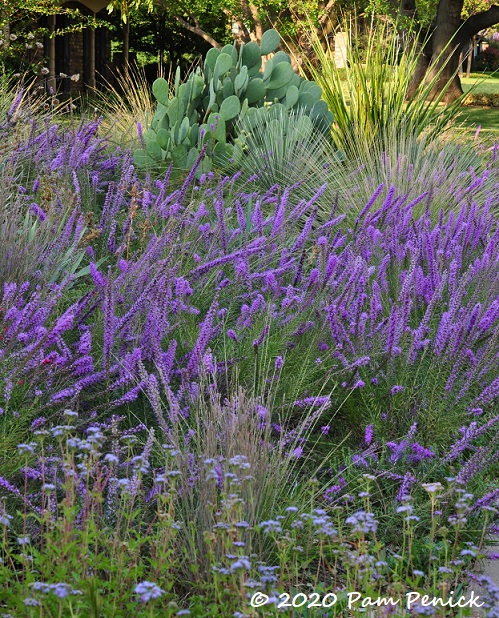
Mistflower and liatris harmonize in blue and purple.
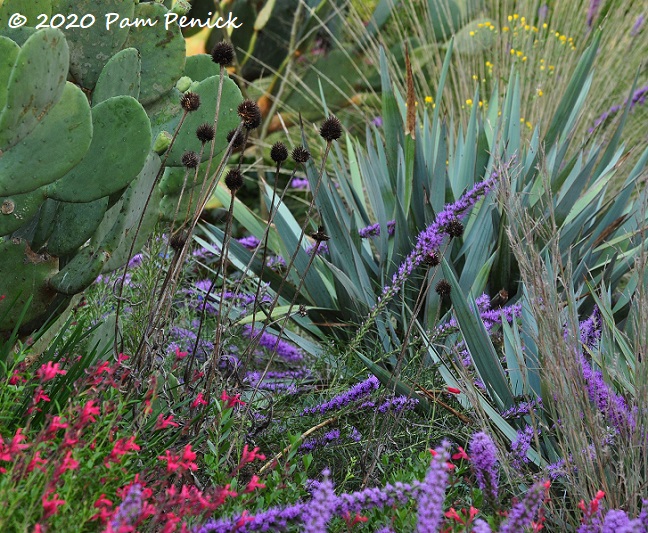
Yucca pallida and prickly pear anchor this vignette of coneflower gone to seed, red autumn sage, and liatris.
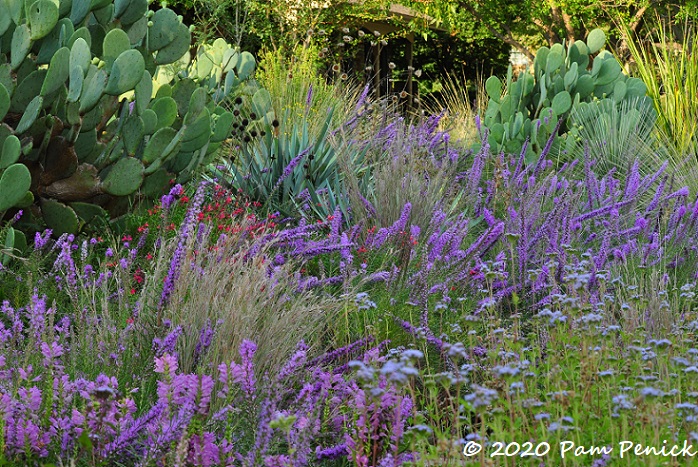
Really, there isn’t a bad angle from which to shoot Michael’s fall-blooming prairie garden.
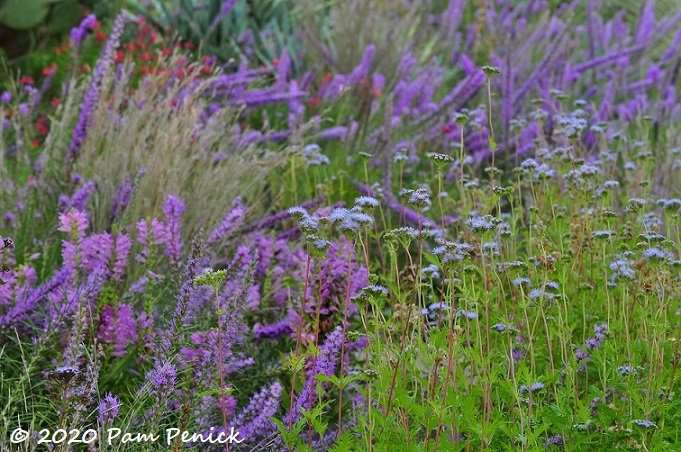
It’s like Monet’s garden evoked in Blackland Prairie plants!
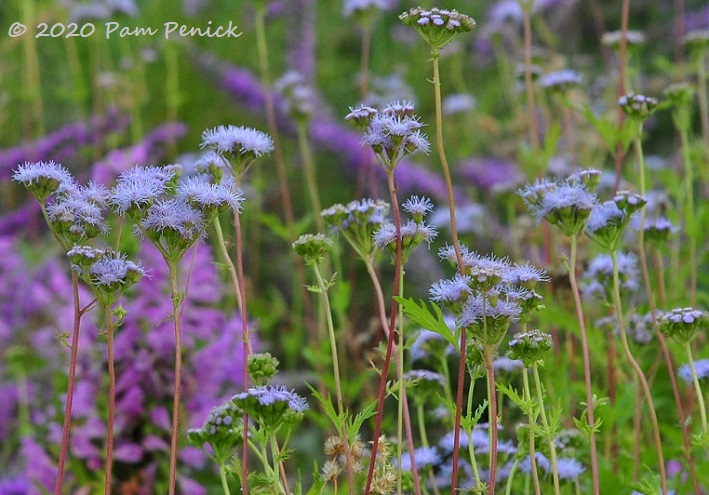
Mistflower
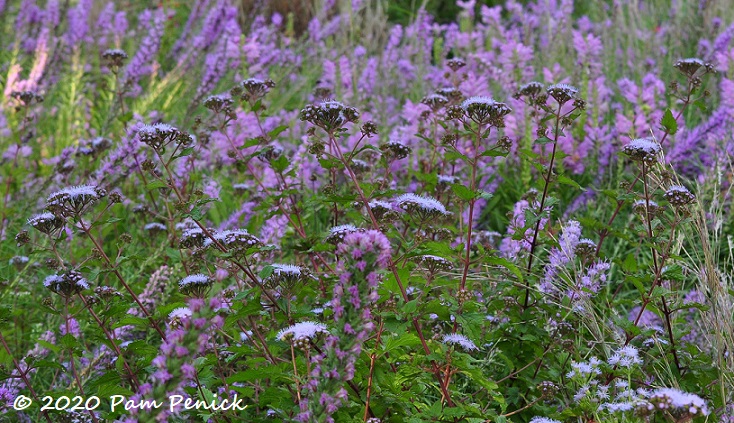
I couldn’t get enough of this blue-purple combo.
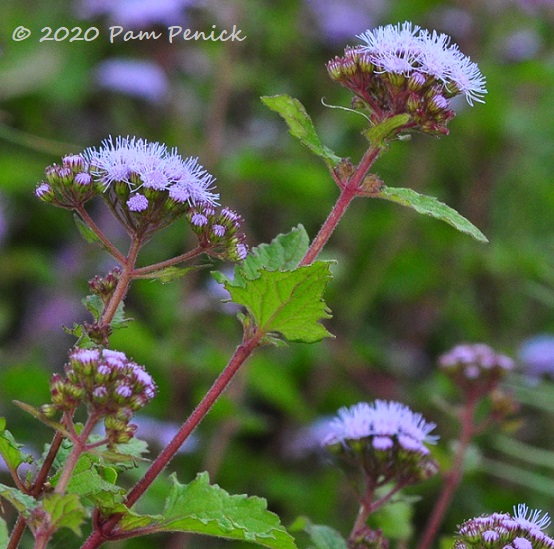
Mistflower closeup
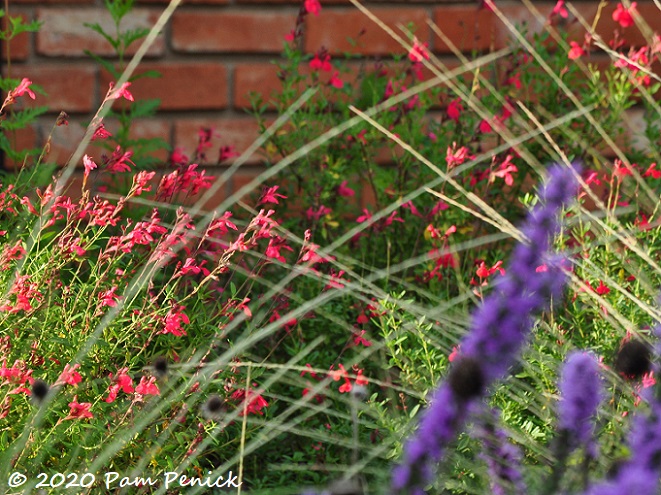
Red autumn sage looking surprisingly good with the red-orange brick of the house
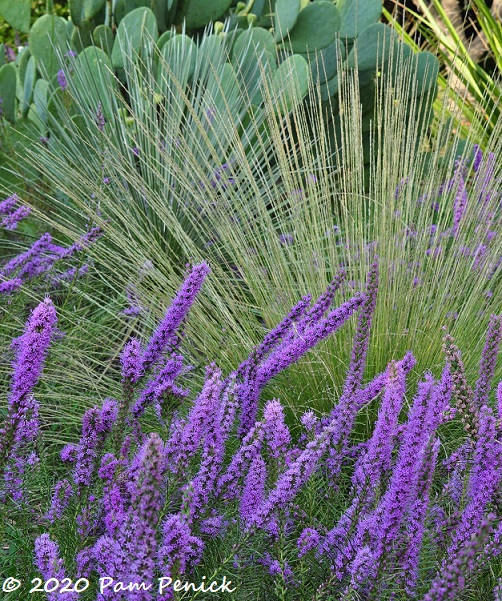
The needle-like (but soft) leaves of pine muhly set off the liatris like a diaphanous scrim.
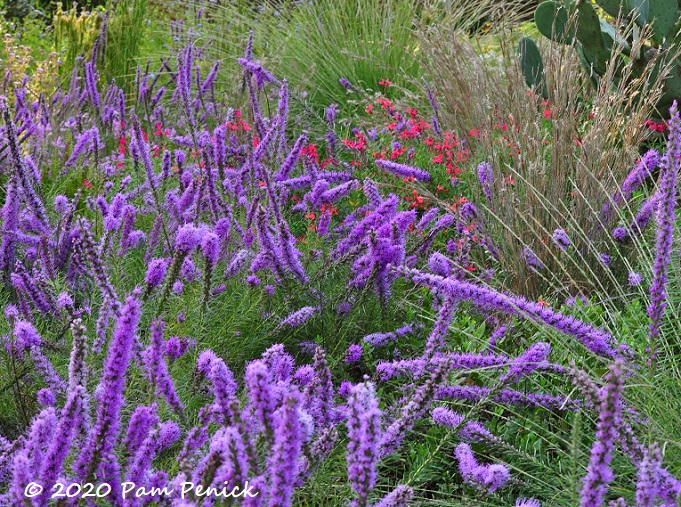
So good!
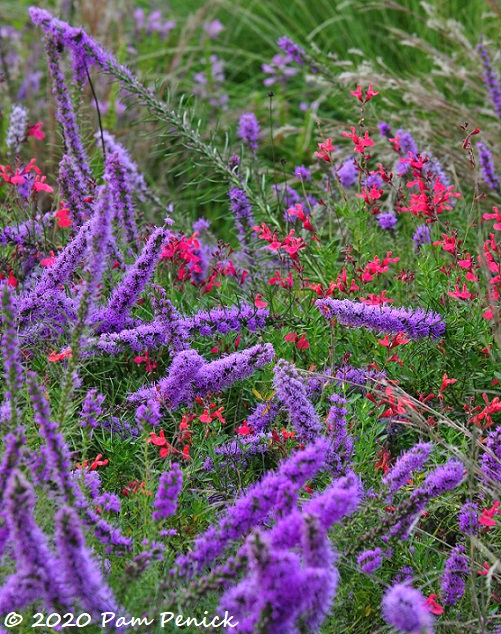
Liatris and autumn sage entangled with each other
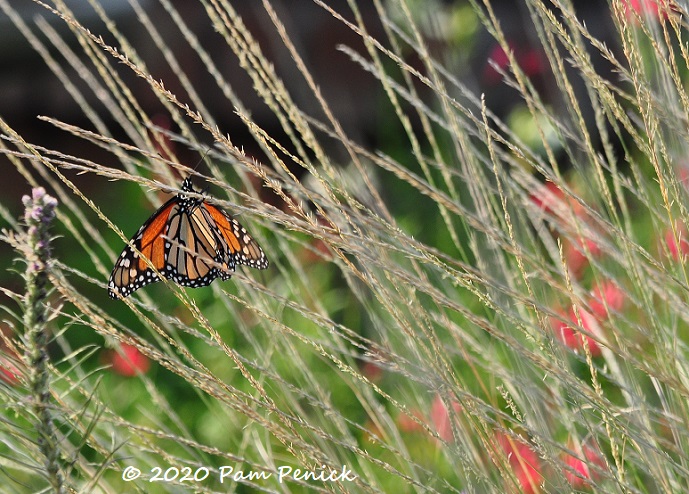
The monarchs were starting to migrate through Dallas on this early October weekend, and I spotted a few warming their wings in the morning sunshine.
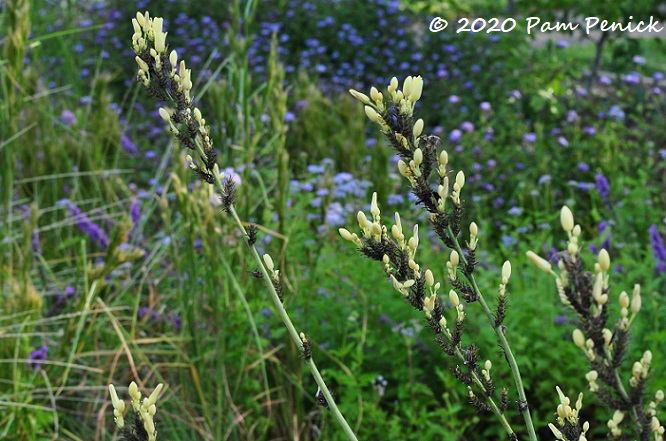
Moonshine-yellow flower wands of a yellow hesperaloe
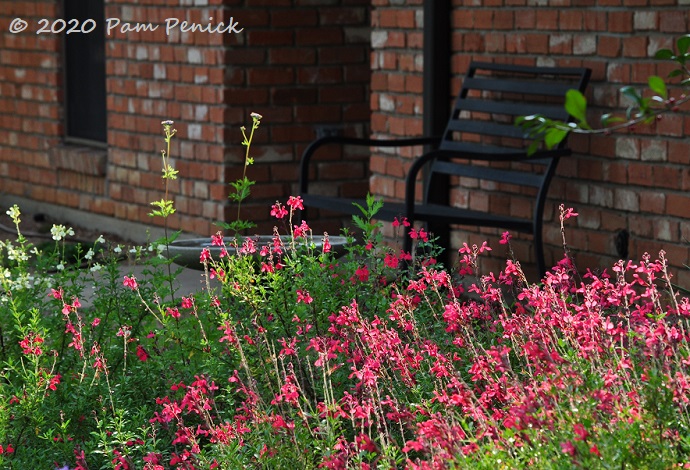
Autumn sage aglow in the early light
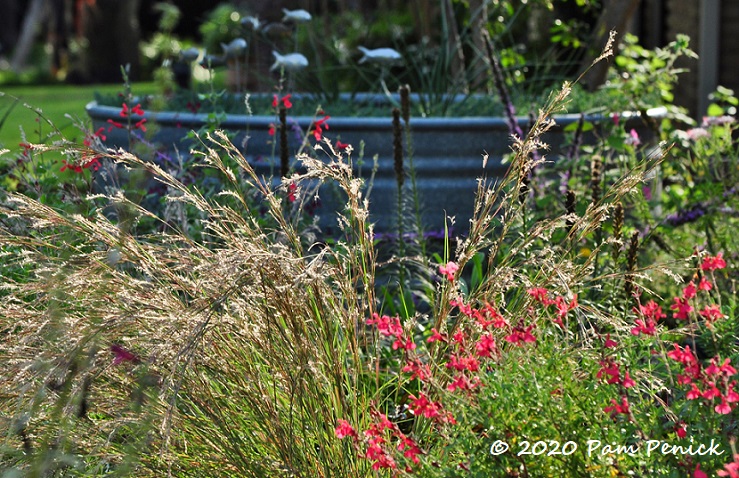
Little bluestem, I think, with autumn sage
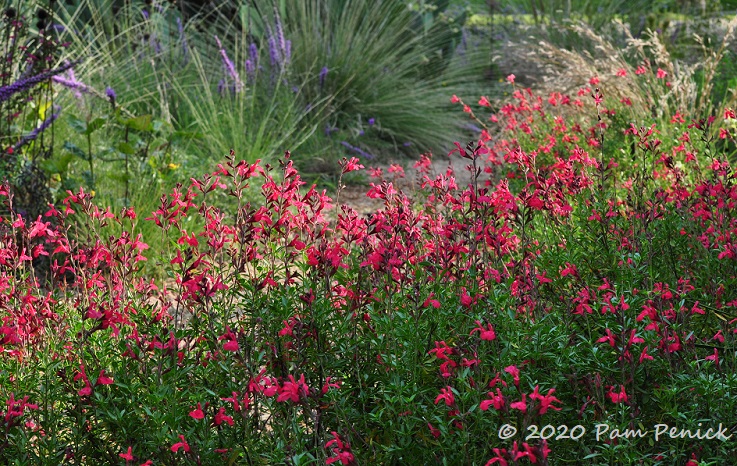
And more!
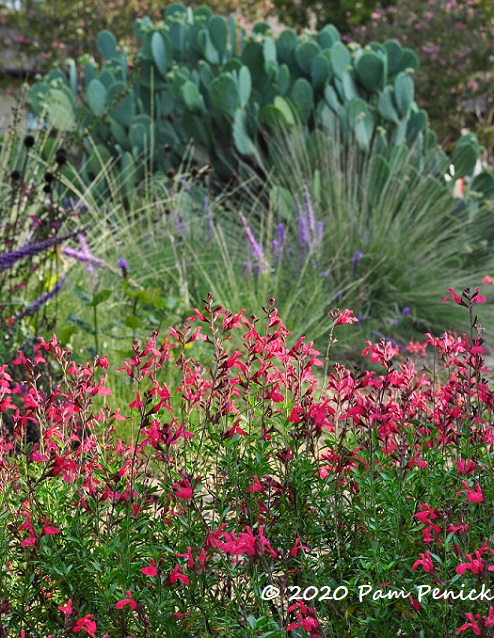
OK, one more of the autumn sage
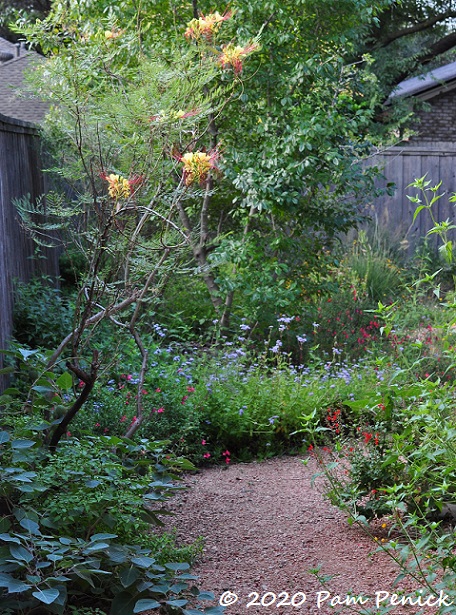
Now let’s head into the side garden, where yellow Bird of Paradise (Caesalpinia gilliesii) offers a few extravagant flowers at head-height.
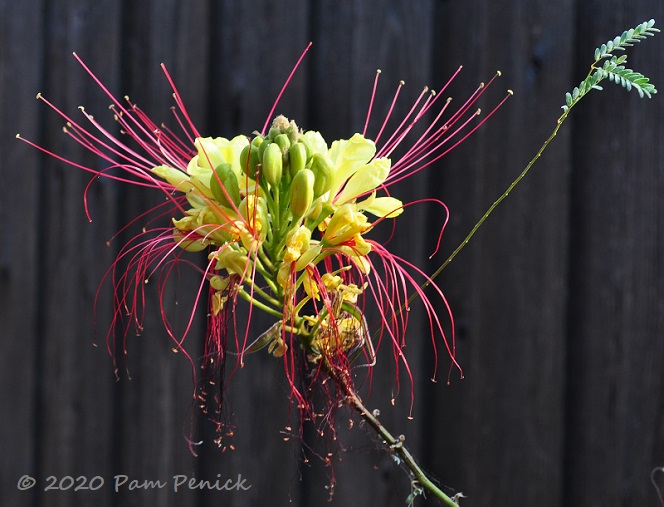
What is going on with these flowers, right? They look like something Dr. Seuss would have invented.
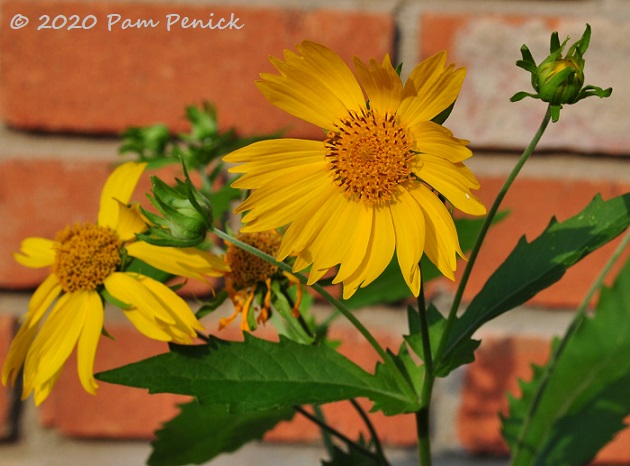
Cowpen daisies (Verbesina encelioides) glow like miniature suns against the warm brick of the house.
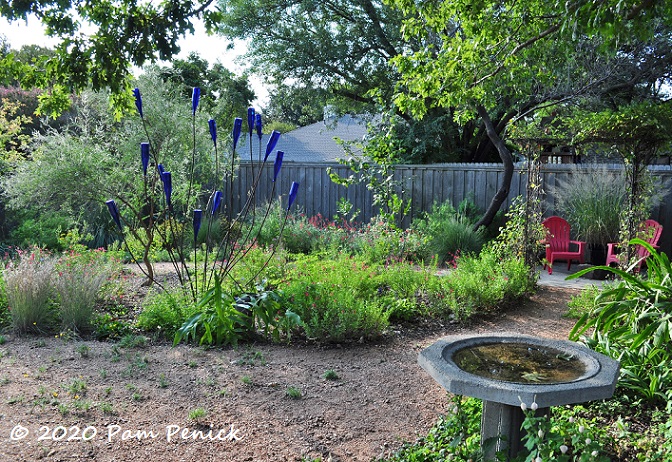
Michael’s back garden is more open than the front, with broad gravel paths surrounding an island bed anchored by a bottle shrub. Over to the right, in line with the view from his back door…
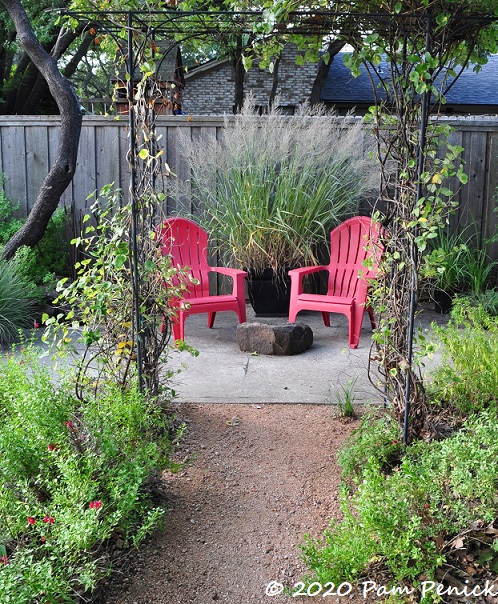
…a vine-covered arbor frames a view of two red Adirondacks and a focal-point potted ‘Dallas Blues’ switchgrass (Panicum virgatum).
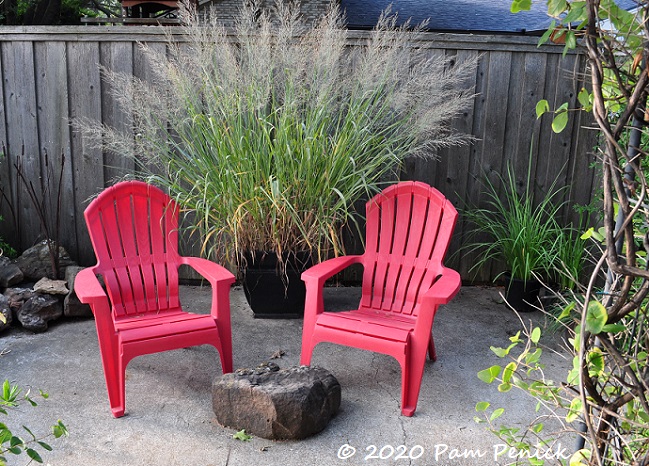
It’s a simple vignette that effectively leads your eye away from the fence and the neighbor’s playscape and roofline and centers it on an inviting seating area. Michael has a clever eye for re-purposing materials from his garden, like this boulder footstool.
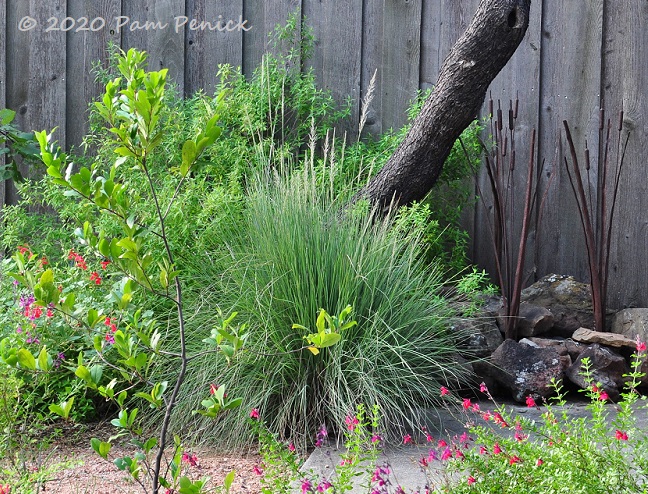
A floofy Lindheimer muhly (Muhlenbergia lindheimeri) draws the eye at left of the patio…
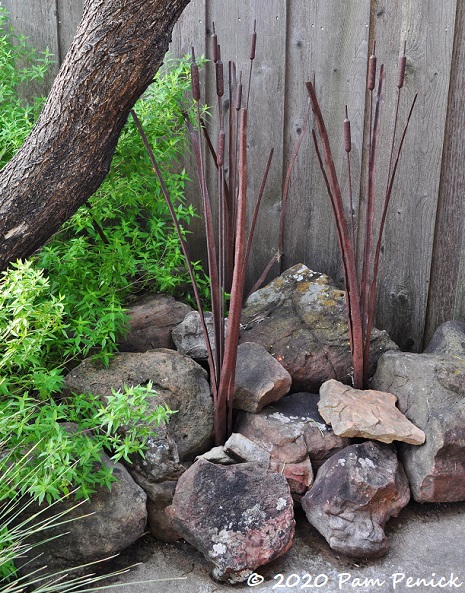
…where another of Michael’s charming vignettes can be admired: a dry pond consisting of leftover small boulders and metal cattails.
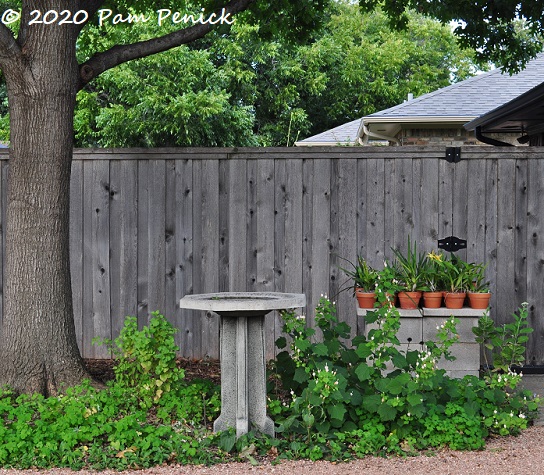
Under a shade tree, a birdbath, white Turk’s cap, and an orchid table make a serene view.
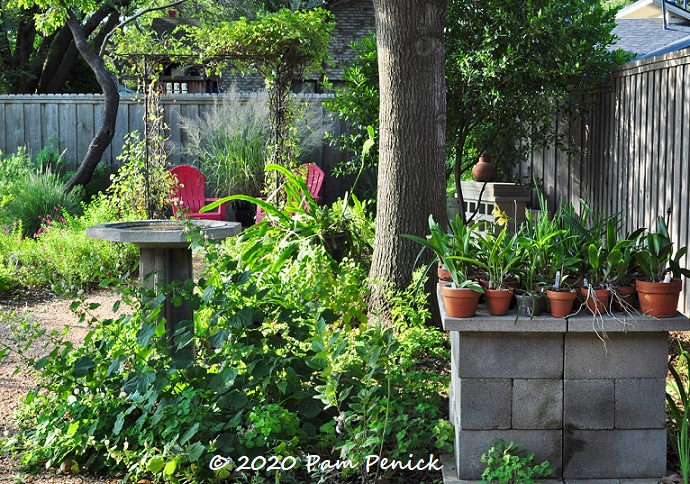
Michael built the display table from cinderblocks and concrete pavers. His orchid collection spends the summer outdoors, soaking up the heat.
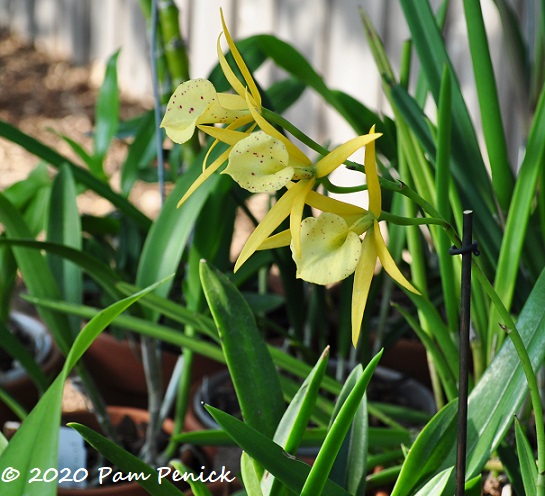
Orchid
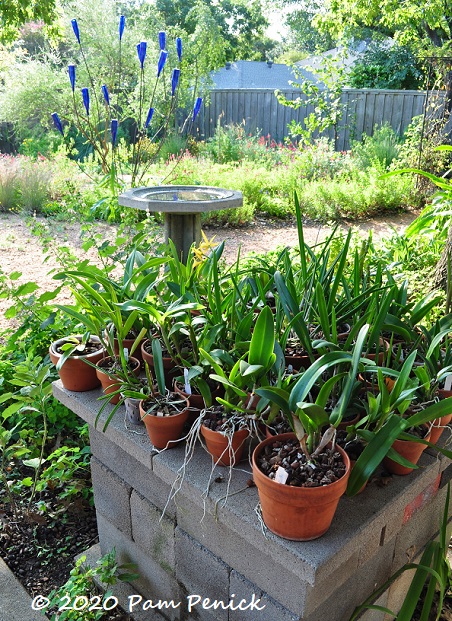
Michael has zero lawn in front or back — a true lawn-gone garden.
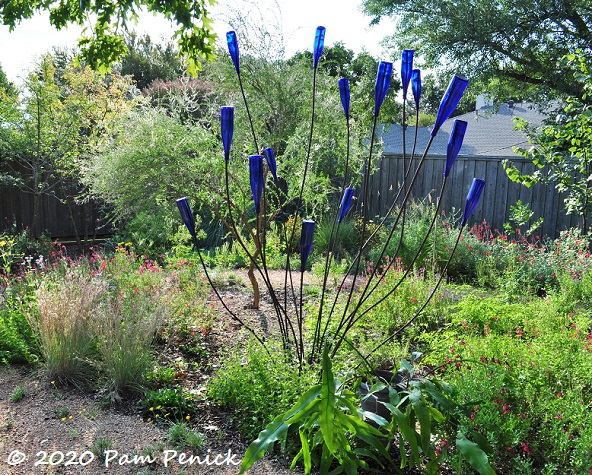
It’s also incredibly water-saving, as he almost never irrigates. He mentioned that a late-summer rain this year brought his plants into fresh flower, which he enjoyed, so he’s considering watering in August or September next year, if there’s been no rain.
Michael’s garden is a bold statement for a suburban neighborhood — or anywhere — and I admire what he’s doing. His Plano prairie garden shows just how beautiful our native Texas plants are, how much a single garden can offer to imperiled pollinators and other wild creatures, and how much enjoyment we can get by planting up our yards with something besides lawn. Thanks for the visit, Michael!
Up next: Exploring the 15-acre urban prairie park at the George W. Bush Presidential Library in Dallas. For a look back at the lakeside garden of Ruth Kinler, owner of Dallas nursery Redenta’s Garden, click here.
__________________________
Digging Deeper
Come learn about gardening and design at Garden Spark! I organize in-person talks by inspiring designers, landscape architects, authors, and gardeners a few times a year in Austin. These are limited-attendance events that sell out quickly, so join the Garden Spark email list to be notified in advance; simply click this link and ask to be added. Season 8 kicks off in fall 2024. Stay tuned for more info!
All material © 2025 by Pam Penick for Digging. Unauthorized reproduction prohibited.


Pam, your photos made the garden look better than real life! I need to learn how to use my camera or get a better one. You even captured one of my new favorite plants, Salvia reptans, in the 5th photo with the yucca. I have not been able to get a good picture of those cobalt blue flowers. It is new this year and should be pretty big next year. Its always good to see you and thanks for signing my Pam Penick books. Look me up if you are in the area during bluebonnet season and want to take pictures.
Michael, thank you, and thanks again for the lovely visit. I definitely hope another 9 years won’t slip by before I see you and your garden again.
What a wonderful garden! Thanks, Pam, for sharing it with us.
It’s my pleasure. Thanks, Lisa!
This entire garden is gorgeous, but the stock tank with the blue spruce sedum and those wonderful silvery fish? OH MY!!!!
Thanks to you and Michael McDowell for a post that greatly cheered me on a dreary, drippy San Antonio morning, and a Very Happy Belated Birthday to you as well, Pam!
Thanks for the birthday wishes, lcp. Seeing Michael’s garden and the others I visited certainly was a good birthday present to myself, hah!
I love it when you get the urge to travel! What an amazing garden and entertaining post. Kudos to Michael for pushing the boundaries and showing his neighbors (and us!) how beautiful native plantings can be. And happy birthday!
Thanks, Maggie. 🙂 And yes, kudos to Michael for showing us how beautiful a native, no-lawn garden can be.
Wow, you caught his garden at a perfect time. It looks great any way you look at it.
I agree, Lisa!
What a lovely garden! All the shades of pinky purple are just swoon worthy!
I’m sitting thru a boring Zoom call and this post is all that has kept me awake.
Thanks Pam & Micheal for a delightful use of the last 10 minutes.
I feel so subversive! 😉 Glad you enjoyed the virtual tour, Paula.
What a beautiful garden! I hope it inspires others to let go of the boring high maintenance lawn. People not in the know might think this would be more effort for how grand and full it is. Thanks for sharing and for your fantastic pics!!
I’m glad you enjoyed them, Kim! And I completely agree that Michael’s garden should inspire others to plant up their yards with pollinator plants, native plants, and more. 🙂
But I don’t know if I can truthfully say that a garden like this is less maintenance than a lawn, especially one that’s not maintained to golf-course standards (with high watering, fertilizing, and mowing). While Michael told me that he almost never irrigates the garden, I’m sure he spends a good deal of time weeding, pruning, moving plants around as needed, replacing under-performers, etc. In other words, gardening. A garden that isn’t tended regularly just wouldn’t look as good as Michael’s.
I think it’s important to point out to newbie gardeners and anyone reading this that a garden doesn’t just happen on its own. It must be tended, and that requires effort. But the rewards for that effort are HUGE. It brings Texas (or wherever you live) into your landscaping, as Lady Bird Johnson emphasized. It helps wildlife. It makes your yard and by extension your neighborhood more interesting and beautiful and inspiring. And most important, perhaps, tending a garden connects you to the earth and to the seasons. It’s enjoyable and restorative and creative and joyful. So maybe a garden takes more time and effort than a simple lawn, but the rewards are great.
And that’s my gardening soapbox speech for today. Hah! Thanks for giving me food for thought, Kim!
I love all that purple color in the front garden. I’ve never grown Liatris but I think I need to look into it. I’m surprised his neighbors haven’t followed his example.
Me too. Lucky them to have his garden to enjoy though!
His garden looks as wonderful as ever. Thanks for taking us along.
My pleasure, Jenny.
His garden is simply dreamy. Thank you for sharing it again.~~Dee
I’m happy to, Dee. Thanks for your comment!
This is just a glorious garden and so wonderfully colorful. I love the bits of whimsy like that tub of sedum with the fish floating over it and the bottle tree. Your photos of everything are great, too!
Thanks, Ellie. I really enjoyed seeing Michael’s garden again and photographing it.
This is a beautiful garden, I love all the plant combinations, I can only imagine the joy of all the butterflies, bees, birds, etc. when they found this oasis. Thank you so much for sharing this garden.
You’re welcome, Doris. I’m glad you enjoyed the virtual tour!
Wonderful pairing of sharp design skills + Texas natives and prairie plants. As you say in the comments, it’s not easy to pull off and takes careful observation, reading, and hard work. Thank you both!
It’s a wonderful garden to have observed over the years. I’m happy to be able to share it again.
I love Michael’s garden! I think he might have been the one who introduced me to pine muhly back in the day, which I use all the time in designs. I just wish it was easier to find! It’s crazy to me that it’s not more popular in retail, considering how small yards are in new builds these days– it’s a great substitute for places where larger grasses like Lindheimer muhly just won’t fit.
Pine muhly IS a terrific looking grass. Michael gave me a volunteer from his garden 9 years ago, and it was gorgeous but then died away. Or so I thought. This summer two new volunteers appeared across the driveway from where I planted the passalong, and now they’re in fall bloom. I couldn’t be happier.